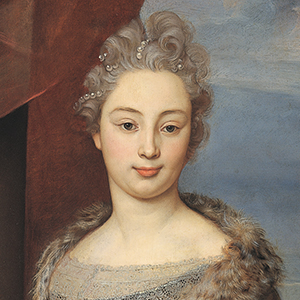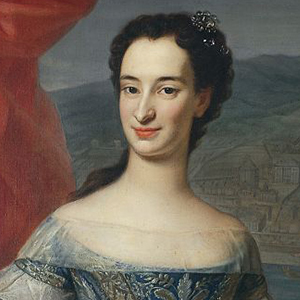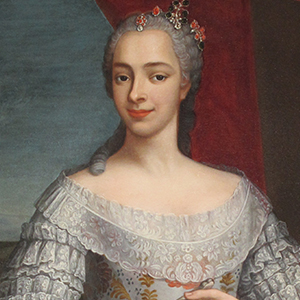The last four rooms on the east side were built by Giovanni Andrea I who commissioned the stucco worker, Marcello Sparzo, from Urbino, to decorate the ceilings, following the death of Andrea Doria. Nowadays, these rooms make up part of the private dwellings of the Doria Pamphiljs, while between 1874 and 1900 they were rented by Giuseppe Verdi and his wife Giuseppina Strepponi. The first work on the arched roof is the depiction of a famous episode in Roman history, dating back to 390 B.C.. Rome was stormed by the Gauls, who then demanded an exorbitant fee in gold as return for its release. At the centre of the artwork, Sparzo shows the moment in which the bounty was weighed. On the walls two magnificent tapestries are on display, representing the months of May and December. In the first, which bears on its lower edge the zodiac sign for Gemini, well-dressed spectators attend an archery competition held during a celebration of spring. Meanwhile in the second, identifiable by the symbol for Capricorn, numerous skaters are shown performing their routines on a frozen lake in the centre of the work. The tapestries were created in the mid-seventeenth century by the royal manufacturer, Gobelins, at the studio of the artist Pierre François Cozette. Also from the seventeenth century are the large mirrors with richly carved and gilded frames, which were produced in Genoa. The room is home to a series of oval portraits of women of the Doria family, as was the fashion of the time. The paintings were done by Domenico Parodi and his studio: for almost half a century the Doria di Melfis went to the artist. He was the son of the sculptor, Filippo, and acted as their principal painter from his early career until his death in 1742. In particular, the portraits of the three women visible to the side of the fireplace have recently been attributed to him. They are: Maria Teresa Doria Tursi, Livia Centurione Doria and Anna Doria Spinelli, all portrayed on their wedding days. The only exception to these is the portrait of the noblewoman in dark blue, which is probably the work of a French artist. The last things to point out, at the centre of the room, are the lavish pieces of furniture. These have different origins, and among them a jewelry box from mid-to-late-fifteenth century Japan, and a carved and painted sled stand out.

The portrait was paid for in 1703, with evidence recently uncovered of a payment of “380 lire to the painter Parodi”. The lady, depicted in the Lodge of Heroes with the garden and Neptune’s fountain faithfully shown in the background, is identifiable as the young Livia Centurione, born in 1685 and wed to Andrea at the age of seventeen. He would not became prince because he died before his father, Giovanni Andrea III. The elegant lady is wearing a refined manteau, created from a particular fabric and characterized by a bizzare flourish, as was the French-imported style of the time.

In 1726, Domenico Parodi worked on this portrait of Teresa Doria Tursi, wife of Giovanni Andrea Doria IV’s cousin, as evidenced on the back of the canvas with the phrase “Parodius Sculptor Pingebat, 1726”. The clothing of the noblewoman is made of very expensive lace and is very formal and lavish, and is probably the same that was worn on her wedding day. The village depicted in the background is Loano, in honour of her groom. The presence in the painting of symbolic elements, such as the the image of Andrea Doria and the family’s crest, act as explicit references to the marital union which followed a strategy that aimed to conserve the lineage. The wedding, carried out against the wishes of the bride, had the objective of uniting the estates of the two branches of the Doria family. However, no children were borne of this marriage, and it was dissolved by the Sacra Rota.

This work, a little less vivacious compared to the previous portraits, can be identified as having been completed in the latter years of Domenico Parodi’s career. It depicts a young lady in refined clothing decorated with flower baskets, while she is accompanied by a puppy, a symbol of loyalty. It portrays Anna, the daughter of Livia Centurione and the younger sister of Giovanni Andrea IV Doria. In 1742, at the age of twenty, she married the Duke of Caivano, Giuseppe Spinelli, and moved to Naples. The painting was commissioned as part of the customary exchange of portraits between the betrothed and would have been sent to her groom-to-be before their wedding.